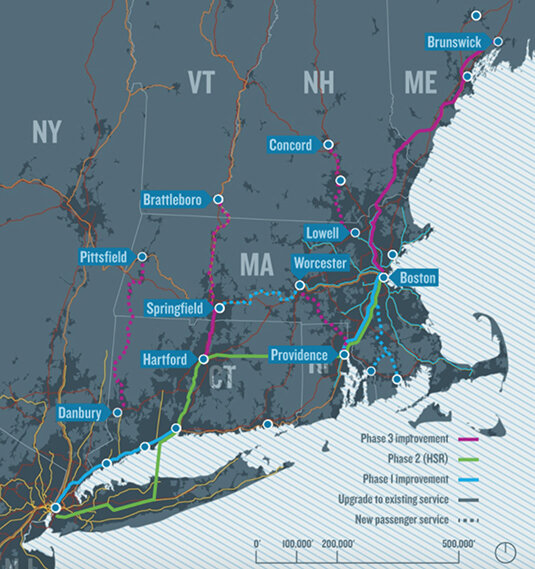Northeast High-Speed Rail Project Races Forward
By GRACE KELLY/ecoRI News staff
A group of transit professionals, activists, elected officials, and organizations want the North Atlantic region to ride the rails into the future.
 |
| Rail travel has no bigger fan than Joe Biden so it's no surprise he likes this plan. Note that unlike the 2017 flap, this plan leaves the CT-RI shoreline, including Charlestown alone. - Will Collette |
It
also calls for bolstering and connecting regional rail networks, paving the way
for a cleaner, more equitable regional transportation system. The trunk line
would operate at 200 mph, and regional and branch lines between 80 and 120.
The NAR initiative also
includes building a 16-mile rail tunnel under Long Island Sound, connecting New
York City to Boston, with stops in Connecticut and Providence, in a 100-minute
ride. In Rhode Island, components include frequent high-speed rails from
Kingston, T.F. Green International Airport, and Providence to Boston.
The idea for a North Atlantic Rail network was born in 2004 as part of a University of Pennsylvania studio project headed by Robert Yaro, a planner and former president of the New York City-based Regional Plan Association.
“We looked at growth trends in the country and identified the emergence of what we call mega regions,” Yaro said. “And these places are all 300 to 600 miles across, so they’re too big to be easily traversed by automobile and too small to be easily, efficiently traversed by the airplane.”Six years later, in
2010, another studio project was hosted after Amtrak came out with a proposal
for a $50 billion project to reduce travel times between New York and
Washington, D.C., by 15 minutes.
“We said, ‘That sounds
like a lot of money for not a lot of benefit,’” Yaro recalled. “So we convened
another studio … with some very talented professional engineering advisors …
and we came up with a high-speed, world-class rail proposal for the Northeast.”
One person who attended
the presentation was Joe Biden.
“Ten minutes into the
presentation and Biden says ‘Goddamnit, I've been waiting for this for 30
years. Let's do it,’” Yaro said.
And now that Biden is president and pushing a $2 trillion sustainable infrastructure and clean energy plan, NAR is putting the pedal to the metal.
“We see this as a kind
of once-in-a-lifetime opportunity to get this thing done,” Yaro said. “The key
to making ticket prices affordable is to have the federal government cover the
capital cost. Until the Georgia Senate races were decided, everybody just kind
of rolled their eyes when we said that, but now it's something that’s a very
serious likelihood. It’s more than a possibility; it’s gonna happen.”
The proposed high-speed rail system would reduce travel times significantly. (North Atlantic Rail)
NAR steering committee
members have estimated that the project would cost a total of $105 billion to
design and build the top priority projects and trunk line.
The benefits of a
high-speed rail go beyond interconnectedness, and NAR proponents believe that it
would also stimulate the economy by creating jobs, result in the creation of
more affordable housing, and promote environmentally friendlier transportation
through electric trains.
According to the International Energy Agency (IEA), rail travel
has a “much lower carbon intensity” compared to other modes of transportation,
such as air and car. IEA also notes that if intensive, aggressive rail
transportation was implemented globally, carbon dioxide emissions could peak by
the late 2030s.
“The next economy that
wants to emerge by disrupting the carbon economy is a green economy,” said
Christopher “Kip” Bergstrom, a project manager at the Connecticut Office of
Policy and Management and member of the NAR steering committee. “Anything that
carbonized is just a dead man walking.”
The NAR also promotes
the idea that high-speed rail will create a more equitable society by allowing
people to easily commute to work and by creating job opportunities and wealth
redistribution within urban areas.
“The opportunity to
reduce our carbon footprint, while simultaneously reducing income inequality,
lies in re-localizing and shortening the chains of supply and distribution; and
in building local wealth and redistributing it in a circular rather than
extractive business model,” wrote Bergstrom in a white paper titled North Atlantic Rail: Building a
Just and Green Economy.
The coronavirus pandemic
has underscored a lot of these societal problems, making pushing this effort
forward all the more urgent.
“I think it’s important
to underscore, why now?” said John Flaherty, deputy director of Grow Smart
Rhode Island, one of the NAR’s associated organizations. “This is about much
more than improved mobility. It’s about an economic recovery, it’s about
climate. In the Northeast 40 percent of the emissions are from the
transportation sector … so unless we do something that’s bold and
transformational, we’re never going to get our arms around that.”

